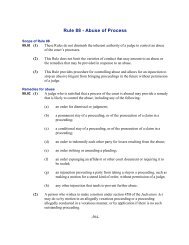Experiments That Changed Nutritional Thinking - TUUM EST
Experiments That Changed Nutritional Thinking - TUUM EST
Experiments That Changed Nutritional Thinking - TUUM EST
Create successful ePaper yourself
Turn your PDF publications into a flip-book with our unique Google optimized e-Paper software.
1048S<br />
SUPPLEMENT<br />
TABLE 1<br />
The first experiment on the effect of diet on radiation mortality in guinea pigs1<br />
Radiation dose (R)<br />
100 150 200 250 300 350 400 500<br />
mortality, %<br />
Cabbage — — 0 10 25 50 75 100<br />
Beets 2.5 — 100 — 100 — 100 —<br />
1 Data from Lourau and Lartigue (1950).<br />
in the two groups, at equal radiation doses, animals fed beets control group would have allowed them to distinguish between<br />
had more severe and widespread hemorrhages than those fed their two explanations (toxic substances in beets vs. protective<br />
cabbage.<br />
substances in cabbage).<br />
The authors proposed two explanations for the dietary effect Spector and Calloway used an oat and bran control diet and<br />
on radiosensitivity. They suggested that 1) cabbage may con- the control diet supplemented with beets, cabbage or broccoli.<br />
tain substances that protect against radiation damage, such as They irradiated their four groups of guinea pigs with a radiation<br />
vitamins P and C; or 2) beets may contain substances that dose of 400 R. Their results are shown in Table 3. Although<br />
become toxic after irradiation. They preferred the second explanation,<br />
beet consumption did not affect mortality, consumption of<br />
that beets were toxic to irradiated guinea pigs. This either cabbage or broccoli significantly reduced mortality from<br />
was supported by the observation that the LD 50 for the animals irradiation. Thus, they proved that Lourau and Lartigue were<br />
consuming beets was about 150 R, considerably lower than incorrect in their conclusion that beets contained a toxic substance<br />
the usually reported LD 50 of 250 R.<br />
and that Duplan was correct as to the protective effects<br />
A few years later, M. Jean-Francois Duplan showed that in of cabbage.<br />
fact, Lourau and Lartigue’s first explanation was correct, that Calloway and colleagues went on to investigate the sub-<br />
cabbage did offer protection against radiation damage (Duplan stance conferring the protective effects (Calloway et al. 1963).<br />
1953). Duplan studied 70 male guinea pigs fed oat and bran Because the basal diet was devoid of vitamin A, and animals<br />
diets. The test diets were supplemented with either cabbage consuming this diet were known to become vitamin A deficient,<br />
or carrots in this study, and the animals received a single<br />
they suggested that sources of vitamin A might be able<br />
radiation dose.<br />
to decrease the radiosensitivity of guinea pigs. Their results<br />
The results of Duplan are shown in Table 2. For a given are shown in Table 3. In this experiment, they confirmed<br />
radiation dose, the animals consuming cabbage had much previous findings that both cabbage and broccoli lowered mortality<br />
lower mortality than those consuming carrots. He saw no differences<br />
in irradiated animals. They found that a number of other<br />
in lesions, but he did note that the animals consuming b-carotene–containing foods also exerted some beneficial effects.<br />
carrots lost much more weight than those consuming cabbage.<br />
Mortality after 20 d was significantly lowered by concarrots<br />
Duplan’s results suggested that Lourau and Lartigue may sumption of the b-carotene–containing vegetables that they<br />
have been incorrect in concluding that beets contained a toxic tested. Beets, apples and white potatoes had no effect. Supple-<br />
substance. Rather than concluding that carrots contained a mentation with all essential vitamins reduced mortality somewhat,<br />
toxic substance, Duplan concluded that cabbage lowered the<br />
but not to the same degree as supplementation with<br />
radiosensitivity of guinea pigs. He speculated that the radioprotective<br />
substances may have been antioxidant goitrogens present<br />
in the cabbage.<br />
Spector and Calloway (1959) continued this investigation<br />
TABLE 3<br />
of the dietary factors that protect against radiation damage. Further experiments on the effect of diet on radiation<br />
They very importantly noted that Lourau and Lartigue did not<br />
mortality in guinea pigs<br />
have a control group in their experiment. The addition of a<br />
Mortality at 20 d after irradiation<br />
with 400 R<br />
TABLE 2<br />
The second experiment on the effect of diet on radiation<br />
mortality in guinea pigs1<br />
Radiation dose (R)<br />
300 500 1000<br />
mortality, %<br />
Cabbage 0 6.5 87.5<br />
Carrots 50 86 —<br />
1 Data from Duplan (1953).<br />
Spector and<br />
Calloway et al.<br />
Supplement Calloway (1959) (1963)<br />
mortality, %<br />
None 100 97<br />
Beets 90 —<br />
Cabbage 50 54<br />
Broccoli 35 42<br />
Alfalfa 0<br />
Mustard greens 12<br />
Green beans 31<br />
Lettuce 44<br />
All vitamins 72<br />
/ 4p09$$0062 04-07-97 14:02:12 nutras LP: J Nut May Suppl<br />
Downloaded from jn.nutrition.org by on June 3, 2010
















